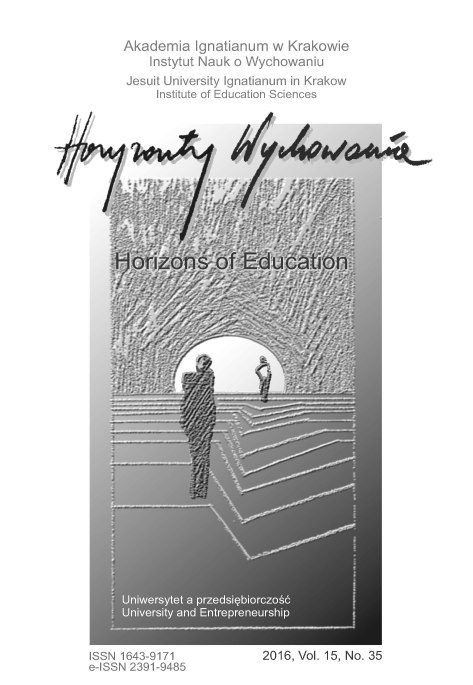Uwarunkowania zarządzania nieruchomościami publicznych uniwersytetów na przykładzie wybranych krajów UE
Abstract
CEL NAUKOWY: Artykuł prezentuje wyniki badań nad uwarunkowaniami zarządzania nieruchomościami publicznych uniwersytetów. Ich celem była próba przedstawienia różnych rozwiązań przyjętych w wybranych krajach UE odnośnie do tytułów prawnych przysługujących uczelniom do nieruchomości, a także form zarządzania nimi.
PROBLEM I METODY BADAWCZE: Do prowadzonych rozważań wykorzystano literaturę przedmiotu, niepublikowane raporty komercyjnych firm oraz informacje zawarte na stronach internetowych poszczególnych zarządców nieruchomości uczelnianych.
PROCES WYWODU: Analizie poddano systemy „nieruchomościowe” szkolnictwa wyższego przyjęte w Austrii, Niemczech, Holandii, Wielkiej Brytanii, Szwecji oraz Polsce.
WYNIKI ANALIZY NAUKOWEJ: Wyniki badań wskazują, iż władze uniwersytetów publicznych w Europie nie ponoszą takiej samej odpowiedzialności za majątek, którym dysponują. Poszczególne państwa przyjęły własne rozwiązania zarówno w zakresie struktury własnościowej nieruchomości, zasad zarządzania, jak i wynajmu nieruchomości.
WNIOSKI, INNOWACJE, REKOMENDACJE: Niezależnie od wielu różnic występujących w systemach akademickich państw europejskich można się pokusić o wymienienie pewnych wspólnych cech. Austriackie, szwedzkie i niemieckie szkoły wyższe nie są właścicielami nieruchomości uczelnianych. Dostarczaniem odpowiedniej dla nich powierzchni na zasadach najmu, a także zarządzaniem majątkiem zajmują się specjalnie powołane do tego celu spółki. Z kolei w Holandii, Hiszpanii, Wielkiej Brytanii oraz Polsce uczelnie posiadają różne tytuły prawne do nieruchomości i zarządzają posiadanymi zasobami.
References
Akademiska Hus. (2014). Organisation. Göteborg: Akademiska Hus. Pozy¬skano z: http://www.akademiskahus.se/en/about us/organisation/ (dostęp: 18.02.2016).
AUDE. (2016). About AUDE: Loughborough: Association of University Directors of Estates. Pozyskano z: http://www.aude.ac.uk/about/ (dostęp: 18.02.2016).
BIG. (2016). Über uns. Wien: Bundesimmobiliengesellschaft. Pozyskano z: http:// www.big.at/ueber uns/ (dostęp: 18.02.2016).
Boys, J. (2011). Towards Creative Learning Spaces. Re thinking the Architecture of Post compulsory Education. London: Routledge, London.
Ćwiąkała Małys, A. (2010). Pomiar efektywności procesu kształcenia w pub¬licznym szkolnictwie akademickim. Wrocław: Wydawnictwo Uniwersytetu Wrocławskiego.
de Vries, J.C., de Jonge, H. i van der Voordt, T.J.M. (2008).
Impact of Real Esta¬te Interventions on Organisational Performance. Journal of Corporate Real Estate, vol. 10, no. 3, 208-223.
den Heijer, A. (2011). Managing the University Campus. Information to Support Real Estate Decisions. Delft: Eburon Academic Publishers.
Expanding private higher education: Key issues for the 2015 Parliament. (2015). Parliament. Pozyskano z: http://www.parliament.uk/business/publications/ research/key issues parliament-2015/education/higher education/ (dostęp: 18.02.2016).
Facts and Figures of the Spanish University System. (2010). Ministry of Education. Pozyskano z: http://www.mecd.gob.es/dms static/bb372186-a6f4-4897-b326-e70dede6ff40/2012-datos y cifras ingles version-20-04-11-pdf.pdf (dostęp: 18.02.2016).
Haynes, B.P. i Nunnington, N. (2010). Corporate Real Estate Asset Management. Strategy and implementation. Oxford: EG Books.
Higher Education in Germany. (2015). The German Rectors’ Conference/Hoch¬schulrektorenkonferenz (HRK). Pozyskano z: https://www.hrk.de/activities/ higher education system/ (dostęp: 18.02.2016).
Higher Education Institutions (HEIs). (2015). Swedish Higher Education Authority. Pozyskano z: http://english.uka.se/higher education system/higher education institutions.html (dostęp: 18.02.2016).
Higher Education Institutions 2014/2015. (2014). OEAD. Pozyskano z: https:// www.oead.at/fileadmin/oead_zentrale/ueber_den_oead/publikationen/pdf/ higher_education/web_high_edu.pdf (dostęp: 18.02.2016).
Jones, K. i White, A.D. (2008). RICS Public Sector. Asset Management Gu¬idelines. A guide to best practice. RICS. Pozyskano z: http://www.lorenz immobilien.net/documents/RICS_Public_Sector_Asset_Management.pdf (dostęp: 12.12.2014).
Kaganova, O. (2012). Guidebook on real property asset management for local governments. Urban Institute Center on International Development and Governance. Pozyskano z: http://www.urban.org/sites/default/files/alfresco/ publication pdfs/412531-Guidebook on Real Property Asset Management for Local Governments.PDF (dostęp: 12.12.2014).
Kamarulzaman, N., Saleh, A.A., Hashim, S.Z., Hashim, H. i Abdul Ghani, A.A. (2011). An Overview of the Influence of Physical Office Environments Towards Employee. Procedia Engineering, vol. 20, 262-268.
Liow, K. i Nappi Choulet, I. (2008). A Combined Perspective of Corporate Real Estate. Journal of Corporate Real Estate, vol. 10, issue 1, 54-67.
Marmot, A. (2014). Managing the Campus. Facility Management and Design, the Student Experience and University Effectiveness. W: P. Temple (ed.), The Physical University. Contours of space and place in higher education. London: Routledge.
Phelps, A. (2010). Rationale, Practice and Outcomes in Municipal Property Asset Management. Journal of Corporate Real Estate, vol. 12, issue 3, 157-174.
Roulac, S. (2001). Corporate Property strategy is Integral to Corporate Business Strategy. Journal of Real Estate Research, vol. 22, no. 1/2, 188-197.
Rymarzak, M. i Trojanowski, D. (2015). Asset Management Determinants of Po¬lish Universities. Journal of Corporate Real Estate, vol. 17, issue 3, 178-197.
Thieme, J.K. (2009). Szkolnictwo wyższe. Wyzwania XXI wieku. Polska, Europa, USA. Warszawa: Difin.
University Property Management Organisations’ Role in the National Property Markets, Benchmarking Nordic University Property Management. (2009). KTI & IPD (raport niepublikowany).
Weatherhead, M. (1997). Real Estate in Corporate Strategy. Southport: Palgrave Macmillan.
Wider European Study. Benchmarking Nordic University Property Management. (2009). KTI & IPD (raport niepublikowany).
Wykaz uczelni publicznych. (2016). Ministerstwo Nauki i Szkolnictwa Wyższego. Pozyskano z: http://www.nauka.gov.pl/uczelnie publiczne/ (dostęp: 18.02.2016).
Copyright (c) 2016 HORIZONS OF EDUCATION

This work is licensed under a Creative Commons Attribution-NonCommercial-NoDerivatives 4.0 International License.
Authors who publish in this journal agree to the following terms:
- Authors retain the copyright to their work while granting the journal the right of first publication. The work will be simultaneously licensed under a CC BY-ND license, which permits others to share the work with proper credit given to the author and the original publication in this journal.
- Authors may enter into additional, non-exclusive agreements for the distribution of the published version of the work (e.g., posting it in an institutional repository or publishing it in another journal), provided that the original publication in this journal is acknowledged.
We allow and encourage authors to share their work online (e.g., in institutional repositories or on personal websites) both before and during the submission process, as this can foster beneficial exchanges and lead to earlier and increased citations of the published work. (See The Effect of Open Access). We recommend using any of the following academic networking platforms:





